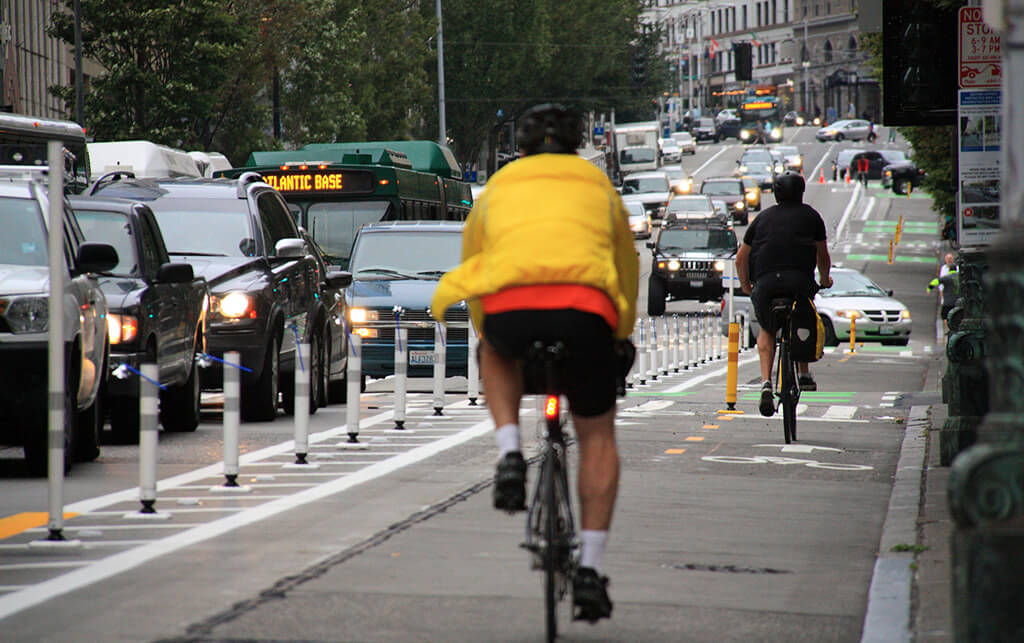Autumn Gear Guide
Find inspiration in our Gear Guide that will keep you out on your bike through wind or rain.
Download NowThe FAST Act dedicates over $4 billion USD to biking and pedestrian projects nationwide.

Photo courtesy of SDOT Photos
Last week the U.S. Congress passed the Fixing America’s Surface Transportation Act, or the FAST Act. The FAST Act is a five-year reauthorization of the Federal Surface Transportation Program. The new bill has promised $835 million USD annually for the first two years and $850 million USD annually for that last three years, for the building and implementing of bicycle and pedestrian projects. This is the first long-term transportation bill approved by Congress in ten years.
With more than $4 billion dedicated, the FAST Act will be funding projects like bike lanes, paths, and trails. Funds will also go towards other safety infrastructure which will hopefully act as incentive to inspire more people to grab a bike.
One major contributor to the passing of the bill was PeopleForBikes. President of PeopleForBikes, Tim Blumenthal, kindly spoke with us about what the FAST Act could mean for bicycling as well as what it took to rally the bicycling community behind the bill.
The FAST Act received a very strong showing of approval within the House of Representatives (vote of 359-65), as well as with the Senate ( vote of 83-16). While cost-effective bicycling infrastructure accounts for less than two percent of total funding under the FAST Act, considering “bipartisan respect and support for the bike/ped components was greater than it’s been in more than a decade, that’s progress,” says Blumenthal.
Currently, bicycling contributes $81 billion USD to the U.S. economy and supports 750,000 jobs. Within that sphere of bike industry, there are 4,800 bicycle retailers, 1,895 bicycle suppliers, and thousands of bike-tourism-related operators. The FAST Act could empower cities to build on the benefits of these businesses and allows for the opportunity to thrive long-term.
It is due hugely to PeopleForBikes that the support for bicycling infrastructure was given its time. “We’ve been following the transportation bill development process very closesly for 16 years,” Blumenthal notes. Formed back in 1991, PeopleForBikes’ principal goal has always been to promote support of federal funding for bicycling. “This year we’ve had half a dozen people in D.C. working on it every day, and we’ve added staff, board and member resources when necessary.”
Subsequently, as finalized plans for the bill drew nearer, it became evident that three amendments had been proposed during the reauthorization process which would have cut major funding sources from bicycling projects. PeopleForBikes drew upon the bicycling community of industry and individual supporters and encouraged them to act quickly. As a result, an overwhelming amount of letters (thousands) were sent to Congress discouraging them from allowing these amendments to come to fruition.
If you are wondering what was prevented – like me – you should know PeopleForBikes countered some pretty serious cuts. For instance, one amendment would have allowed for the diverting of all Transportation Alternative Program (TAP) funds to non-TAP purposes. A second amendment would have eliminated the eligibility of recreational trails and bike/ped projects – “one of the largest and historically most flexible pots of federal transportation money.” The last amendment would have “completely eliminated the Recreational Trails Program which pays for natural surface trails,” notes Blumenthal. Cue nationwide wiping of the brow.
This has been a long process, surely. PeopleForBikes as well as many others had to work very hard to emphasize the economic and community benefits of funding bike infrastructure. “We don’t deserve all the credit,” Blumenthal relates, “but opponents of bike infrastructure investments consistently failed when they tried to label our programs as frivolous.”
Bicycle programs may be many things, but foolish and trivial they certainly are not. Biking programs outlined in the FAST Act will continue to improve infrastructure coast to coast and help communities respond to a growing bike commuting population, and to continue to encourage its growth. Blumenthal subsequently adds that “Seamless, interconnected networks that provide safe and appealing experiences for all bike riders will become more widespread… investment in rail-trails, singletrack, pump tracks and bike parks will continue, and will provide tourism and economic development benefits.”
These programs may take time, however, the improvements will benefit not just the bike industry, but also all communities and individuals that reside there.
This all said, it is important to remember that the FAST Act is “just on step among many to advance bicycling as active transportation,” Blumenthal reminds us. “It’s big-money and multi-year, which makes it significant.” We need to take this step forward and realize what can be accomplished but also acknowledge that the future of bicycling is being shaped now and the next few years are crucial.
Blumenthal discloses one last encouraging notion: “Don’t think first about what communities can do for bicycling, think about what bicycling can do for communities—a lot of good things.”
Find inspiration in our Gear Guide that will keep you out on your bike through wind or rain.
Download Now
Leave a comment